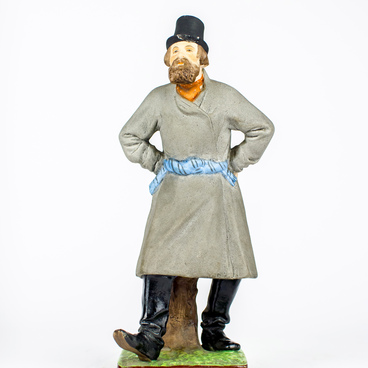his teacup and saucer set of one was manufactured by the Porcelain Factory of Fyodor Terekhov and Afanasy Kiselev.
The factory was founded in 1821. It was located in Moscow province in the village of Rechitsy. The founders were two brothers and peasants, Fyodor and Ivan Terekhov, who were famous clay miners. Afanasy Kiselev was an ordinary factory supervisor, who served there since 1822. In 1832, he married the daughter of one of the Terekhovs, contributed his capital to the enterprise and became its co-owner.
At the first Moscow exhibition held in 1831 the factory presented their products: dishes of white, painted in “kramsovy” (bright scarlet) and “dikiy” (silver) colors, as well as products with gilding. The earthenware of the local “peasant” factory was exhibited next to the products of the largest porcelain factories — The Kiev-Mezhyhirya Earthenware Factory and the Auerbach Factory. Contemporaries noted the high quality of “Terekhovsky” faience. “The latest products are not inferior to foreign ones in quality, for which factory are obliged to Kiselev, who was a peasant farmer. He is succeeded in this without any outside guidance, just by his observations and various experiments in making earthenware mixtures”, — stated a note submitted to the Minister of the Imperial Court in March 1831.
The factory workers were encouraged not only by cash bonuses. In 1831, at the behest of Nicholas I, the factory workers were awarded ceremonial kaftans (a men’s long suit with tight sleeves) “for improving the production of earthenware and encouraging other peasants of the village of Gzhel and the distribution of earthenware in an improved form”.
In 1832, for achievements in the development of national industry, Fyodor and Pyotr Terekhov and Afanasy Kiselev were awarded silver medals with the inscription “For Usefulness” to be worn on the Saint Anna ribbon.
The earthenware of the Terekhov brothers and Kiselev were exhibited at many industrial exhibitions in Moscow and St. Petersburg — in 1833, 1835, 1843 and 1849. At the 1833 exhibition the factory founders presented a wide range of products: dinner sets, dinner plates and soup plates, saucepans, salad bowls, dishes for ice, flower jars, jugs of various kinds. After the exhibition the peasant brothers Terekhovs and Kiselev were awarded small gold medals for their improvement of earthenware products.
After the 1843 exhibition, the reviewer wrote:
The factory was founded in 1821. It was located in Moscow province in the village of Rechitsy. The founders were two brothers and peasants, Fyodor and Ivan Terekhov, who were famous clay miners. Afanasy Kiselev was an ordinary factory supervisor, who served there since 1822. In 1832, he married the daughter of one of the Terekhovs, contributed his capital to the enterprise and became its co-owner.
At the first Moscow exhibition held in 1831 the factory presented their products: dishes of white, painted in “kramsovy” (bright scarlet) and “dikiy” (silver) colors, as well as products with gilding. The earthenware of the local “peasant” factory was exhibited next to the products of the largest porcelain factories — The Kiev-Mezhyhirya Earthenware Factory and the Auerbach Factory. Contemporaries noted the high quality of “Terekhovsky” faience. “The latest products are not inferior to foreign ones in quality, for which factory are obliged to Kiselev, who was a peasant farmer. He is succeeded in this without any outside guidance, just by his observations and various experiments in making earthenware mixtures”, — stated a note submitted to the Minister of the Imperial Court in March 1831.
The factory workers were encouraged not only by cash bonuses. In 1831, at the behest of Nicholas I, the factory workers were awarded ceremonial kaftans (a men’s long suit with tight sleeves) “for improving the production of earthenware and encouraging other peasants of the village of Gzhel and the distribution of earthenware in an improved form”.
In 1832, for achievements in the development of national industry, Fyodor and Pyotr Terekhov and Afanasy Kiselev were awarded silver medals with the inscription “For Usefulness” to be worn on the Saint Anna ribbon.
The earthenware of the Terekhov brothers and Kiselev were exhibited at many industrial exhibitions in Moscow and St. Petersburg — in 1833, 1835, 1843 and 1849. At the 1833 exhibition the factory founders presented a wide range of products: dinner sets, dinner plates and soup plates, saucepans, salad bowls, dishes for ice, flower jars, jugs of various kinds. After the exhibition the peasant brothers Terekhovs and Kiselev were awarded small gold medals for their improvement of earthenware products.
After the 1843 exhibition, the reviewer wrote:



